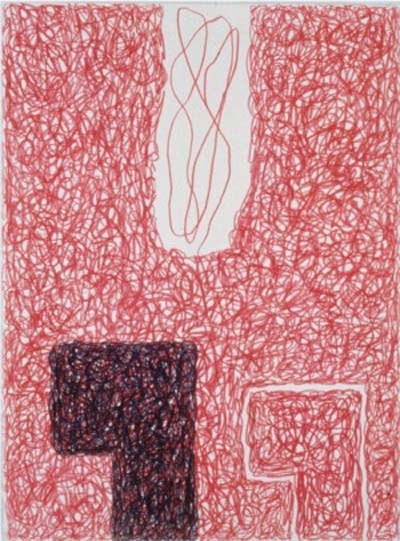 Untitled, 2001 Graphite and India Ink on Paper 22 x 30 inches Jonathan Lasker Zeichnungen Click for English text Johnathan Lasker wurde 1948 in Jersey City, New Jersey, USA, geboren und lebt und arbeitet in New York. Er gehört zu den bedeutendsten Malern seiner Generation und wird in diesem Jahr u.a. mit umfassenden Retrospektiven vom Centro Reina Sofia, Madrid und in der Kunstsammlung NRW "K20" gewürdigt. Wie seine Zeitgenossen Peter Halley, Ross Bleckner und Philippe Taffee, ist Lasker geprägt durch das Informationszeitalter, welches er in einer Verbindung zwischen Kunst und Massenmedien zu reflektieren sucht. Vor diesen Entwicklungen bemüht Lasker sich einer neuen Verortung der Funktionen von Malerei und Zeichnung. Gleichzeitig blickt Jonathan Lasker auf eine reiche malerische Tradition im 20. Jahrhundert zurück und reflektiert einige ihrer wichtigsten Positionen. In der Nachfolge einer Generation strenger Formalisten wie Robert Ryman, Brice Marden oder Sean Scully nutzt Lasker konzeptuelle Verfahrensweisen von Matisse und Mondrian genauso wie die Zeichnungen des surrealistischen Automatismus und die dichten malerischen Strukturen des Abstrakten Expressionismus. Schliesslich ist sein Werk auch von Vorbildern wie Robert Rauschenberg und Jasper Johns nicht zu trennen. Die in der Ausstellung gezeigten Zeichnungen geben einen typischen Eindruck von Laskers besonderem Zugang zu einem malerischen Prozess wieder, der stark konzeptuell geprägt ist. Die Arbeiten sind kontrolliert und behutsam komponiert und wirken durch ein ausgewogenes Arrangement an Formen und strukturellen Elementen sowie beeindruckender Verhältnisse von Formen zur Fläche als komplex-singuläre Werke. Sie stehen zugleich am Anfang von Laskers malerischem Prozess, in dem das Bild weit über die Idee einer strengen Form hinausweist und auf einer reflexiven Ebene eindrücklich seinen eigenen Entstehungsfortgang thematisiert. Beginnend mit einfachen strukturellen Elementen, wie sie etwa in der Kaligraphie zu finden sind oder als Kritzeleien am Papierrand, entwickelt Lasker kleine und prototypische Entwürfe, die dann präzise in grossformatige Arbeiten übertragen werden. Während der verschiedenen Stationen auf dem Weg zum abgeschlossenen Bild fügen sich Reflektionen und Darstellungen der vorbereitenden "unbewussten" Skizzen Stück um Stück zusammen. Die Arbeit wird derart zu einer Dokumentation der Entstehung ihrer selbst. Ausstellungsdauer: 2.6. - 26.7.2003 Oeffnungszeiten: Mo-Fr 11 - 18 Uhr, Sa 11 - 15 Uhr Galerie Thomas Schulte Mommsenstrasse 56 D-10 629 Berlin Telefon +49 30 324 00 44 Fax +49 30 345 15 96 E-Mail mail@galeriethomasschulte.de www.galeriethomasschulte.de Jonathan Lasker Drawings Johnathan Lasker was born in 1948 in Jersey City and is currently living and working in New York. Like his contemporaries Peter Halley, Ross Bleckner, and Philippe Taffee, Lasker is a child of the information age, who reflects on the new relation between art and mass communication and researches the new function and purpose of painting in a conceptually minded environment. Adopting and at the same time reviewing some of the most significant steps painting took in the 20th century Lasker makes painterly language his subject arriving at a highly sophisticated solution. Following a heroic generation of formalists like Ryman, Marden or Scully he incorporates the compositional and planning approaches of Matisse and Mondrian as well as the automatic drawing of Surrealism and the dense patterns of Abstract Expressionism. At the same time he identifies with the detached aesthetics of Rauschenberg and Johns. The drawings shown in this exhibition are typical for Lasker's specific approach to the pictorial process which is highly conceptual. The works goes beyond the idea of pure form and focuses on the development and execution of the drawings, reflecting on itself. Starting with small structural elements such as calligraphic symbols or scribbles that are found in a way of "automatic drawing" Lasker develops small prototypical sketches that are later copied into large scale works. The different stages of arriving at the final painting add layer upon layer of reflection and depiction of the original "unconsciously" conceived original composition. The work becomes a representation of the process of its own making. In this meaning the drawings of Johnathan Lasker inherit a very strong part from the first step to the final painting Nevertheless the drawings seems already controlled, carefully composed, achieving harmony through calculated and balanced arrangement of forms and structural elements and strikingly balanced figure-ground relationships in the contrast with the background, card-like calligraphic insertions and radical impasto that reaches out over the Matisse-like flat colour treatment of the largest parts of the drawings surface. Lasker such achieves to formulate an original, intelligent and informed concept of painting that must be seen as an important step in the history of painting and the reflection of its purpose and self-regard. June 2 - July 26, 2003 |